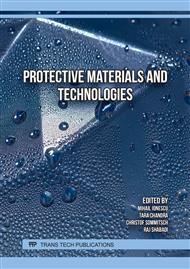[1]
S.J. Eichhorn, A. Dufresne, M. Aranguren, N. E. Marcovich, J. R. Capadona, S. J. Rowan, C. Weder, W. Thielemans, M. Roman, S. Renneckar, W. Gindl, S. Veigel, J. Keckes, H. Yano, K. Abe, M. Nogi, A. N. Nakagaito, A. Mangalam, J. Simonsen, A. S. Benight, A. Bismarck, L. A. Berglund and T. Peijs, Review: Current international research into cellulose nanofibres and nanocomposites, Journal of Materials Science, 45 (2010) 1-33.
DOI: 10.1007/s10853-009-3874-0
Google Scholar
[2]
H. Yano, Cellulose nanofibers and their utilization, Journal of The Imaging Society Japan, 55 (2016) 356-360.
Google Scholar
[3]
H.T. Phuong, N. K. Thoa, P. T. A. Tuyet, Q. N. Van and Y. D. Hai, Cellulose nanomaterials as a future, sustainable and renewable material, Crystals, 12 (2022) 106.
DOI: 10.3390/cryst12010106
Google Scholar
[4]
A. Isogai, Cellulose nanofibers, Journal of The Surface Finishing Society of Japan 71 (2020) 389-395.
Google Scholar
[5]
H. Yano, Production of cellulose nanofibers and their applications, Journal of The Society of Rubber Science and Technology, Japan 85 (2012) 376-381.
Google Scholar
[6]
N.R. Savadekar and S.T. Mhaske, Synthesis of nano cellulose fibers and effect on thermoplastics starch based films, Carbohydrate Polymers 89 (2012) 146-151.
DOI: 10.1016/j.carbpol.2012.02.063
Google Scholar
[7]
D. Moon, K. Tsukahara, M. Sagisaka and K. Tahara, Effect of cellulose nanofibers composites in automotive components on greenhouse gas emissions, Journal of the Japan Institute of Energy 95 (2016) 648-652.
DOI: 10.3775/jie.95.648
Google Scholar
[8]
M. N. F. Norrrahim, N. A. M. Kasim, V. F. Knight, N. A. Halim, N. A. A. Shah, S. A. M. Noor, S. H. Jamal, K. K. Ong, W. M. Z. W. Yunus, M. A. A. Farid, M. A. Jenol and I. R. Ahmad, Performance evaluation of cellulose nanofiber reinforced polymer composites, Functional Composites and Structures 3 (2021) 024001.
DOI: 10.1088/2631-6331/abeef6
Google Scholar
[9]
M. Iioka, W. Kawanabe, I. Shohji, T. Kobayashi, An experimental study of fabrication of cellulose nano-fiber composited Ni film by electroplating, Materials Transactions 63 (2022) 821-828.
DOI: 10.2320/matertrans.mt-mc2022012
Google Scholar
[10]
I. Shohji, S. Arai, J. Uchikawa, T. Matsui, E. Kobayashi, Wear properties of electroless Ni-P plated Al alloy and polyacetal, Journal of The Surface Finishing Society of Japan 58 (2007) 846-850.
DOI: 10.4139/sfj.58.846
Google Scholar



